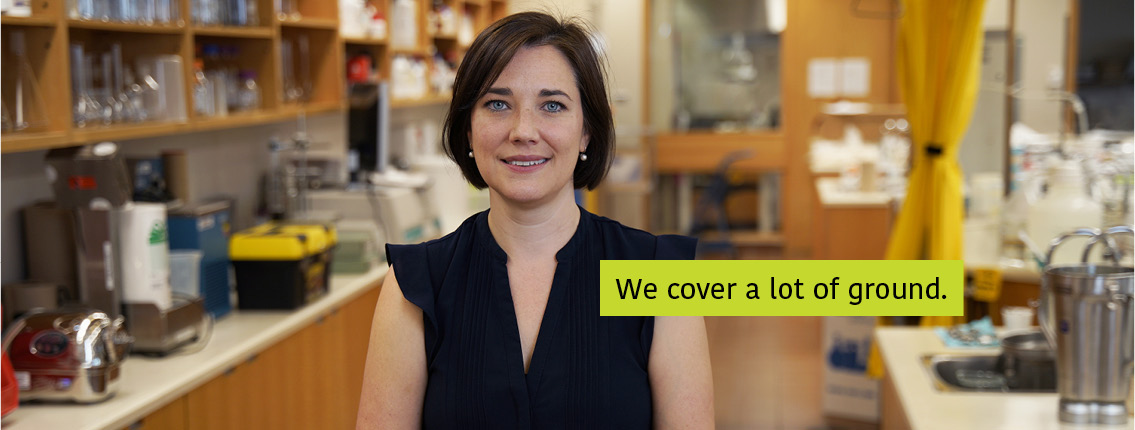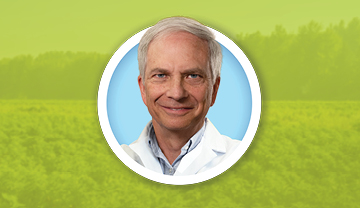
Dr. Julie Brassard
Research Scientist – Food and Environmental Virology
Saint-Hyacinthe Research and Development Centre
Why did you become a scientist?
I have always been impressed by nature, biology and things that are alive but not seen. As a child, "why this and why that" came very easily to me, and my parents made me read the encyclopedia!
Meet Dr. Julie Brassard
Video transcript
[Upbeat, cheerful music begins.]
[Julie Brassard is walking up the stairs at the Saint-Hyacinthe research centre in Quebec.]
[A green geotag icon appears on the bottom of the screen with text.]
Text on screen: Saint-Hyacinthe, Que.
Voice of Julie Brassard:The scientific question I am trying to solve in my work is how to better understand the way that viruses persist in the environment or on food.
[Julie walks down hallway towards lab.]
[Julie uses pass to open a door and enters a room.]
Julie: One in eight people in Canada might contract a disease from contaminated food every year, whether it is bacteria or viruses.
[Julie grabs a lab-coat off a hook on the wall and puts it on.]
[Cut to close up shot of Julie in a lab sitting for an interview.]
[A green and white banner crosses the bottom left corner of the screen with text on it.]
Text on screen: Julie Brassard (Ph. D.) Chercheuse scientifique-Virologie alimentaire et environnementale. Agriculture et Agroalimentaire Canada
Julie: My name is Julie Brassard, and I am a research scientist in food virology.
[Cut to Julie wearing lab coat walking through the lab and checking in with one of her team members who is conducting some testing.]
Julie: The work being done to understand these viruses will make it possible to reduce the number of foodborne toxins and illnesses.
[Cut to clip of cheese on a conveyer belt in a cheese processing plant.]
Julie: There are producers, processors and farmers who are facing challenges such as diseases in their herds and crops or climate change.
[Cut to a grain harvester cutting through a wheat field.]
[Cut to a heard of cows walking in a field.]
[Cut to a man husking a corn in a corn field.]
Julie: It takes research to find solutions to help them.
[Cut back to Julie and her colleague in the lab placing a sample under a microscope.]
[Cut back to Julie sitting being interviewed.]
Julie: So, through my work, I bring knowledge and innovations that can be applied on the farm, in the field or in the factory and that will help them continue to produce quality food.
[Cut to close-up of a sample tray under a microscope.]
[Cut back to Julie.]
Julie: There is always a certain challenge, because there’s a problem and we want to find a solution.
[Cut to close-up moving image of a virus.]
[Cut to close-up moving image of a DNA strand.]
[Cut to close-up of a droplet coming out of an eye-dropper.]
[Cut to droplets falling into test tube.]
Julie: We work with viruses, DNA... all things that are invisible to the naked eye, so we often put microdroplets into microtubes, then mix it, incubate it.
[Cut to image of a chart with results on it.]
Julie: And at the end of the day, we’ll see a small strip on a gel exactly where it was calculated to be. At those times, we’re really happy.
[Cut back to Julie.]
Julie: It gives us the energy to continue doing research.
[Cut to Julie and her colleague examining an image on a screen in the lab.]
Julie: Research scientists in Canada, we’re all dedicated to our work and we really want to provide solutions for both people’s health and producers.
[Cut back to Julie.]
Julie: We care about the health of Canadians and how food is made in Canada.
[Cut to an ending text screen on a white backgorund.]
Text on screen: Learn more at agr.gc.ca/fields-of-science. We cover a lot of ground.
[The Canada wordmark appears. The music fades out.]
Profile
What do you like the most about your job?
The creative aspect of the researcher's work, since we have to observe things that we don't always understand, and researchers have to find a way to explain them by adapting or creating methods and experiments. There's a lot of creativity in a researcher's work, and imagination is really an important asset!
What was the biggest challenge you have ever encountered in your career?
Like many young working parents, the challenge for me was balancing work and family life at the start of my career. Now my children are older and everything is easier, but the first 10 years were intense!
If your field of science was a "Top 20" song, what would it be called?
"I Still Haven't Found What I'm Looking For" by U2, for my career; "Toujours Vivant" by Gerry Boulet, to describe the persistence of viruses; and "Money" by Pink Floyd, because that's our main concern as researchers!
What is your favourite food?
A nice tomato sandwich: toast, mayonnaise, salt and pepper, and tomatoes from my garden—nothing else!

What is the funniest thing that has happened to you at work?
When I present at a scientific conference, I still get asked: "what are you going to do after your graduate studies?" It's flattering to be asked that at the beginning of your career, but not after 16 years as a researcher! Now I say I'm going to retire!
I'm also the official creator of the research centre's ping pong tournament trophy!
Viruses: An eye on the big picture
Dr. Julie Brassard has a passion for viruses. Viruses are tiny organisms that can make you sick in a matter of hours. She is part of a team of researchers that helps us better understand viruses. "Our immune systems are very complex, yet some viruses can effectively bypass them and make us sick so quickly", says Dr. Brassard, a food and environmental virologist based at Agriculture and Agri Food Canada’s Saint Hyacinthe Research and Development Centre. "The more I learn about them, the more fascinating I find them."
Dr. Brassard and her team use a "one health" approach that looks at the big picture of diseases and how viruses travel between humans, animals and the environment. That is because many viruses naturally circulate among animals, humans and the environment, including water. For example, hepatitis E virus (HEV) is found in pigs worldwide. The pigs are not affected by the virus, but act as a host. The virus can be transmitted to humans who eat contaminated under-cooked meat. While the risk of contracting the disease is low in Canada, its potential for harm means that finding the best measures to reduce the spread of the virus continues to be important.
Dr. Brassard’s team is working hard to discover the sources of HEV, how it spreads, and how it survives. Their research will help teach people how to control HEV — in barns, abattoirs or barbecues.
"Farmers and others in the agri food industry face many challenges as they work hard to keep our food safe", says Dr. Brassard. "I feel privileged to be able to support them by providing new knowledge, scientific advances and innovations to protect people, animals, our food industry and our economy."


